Margot Note's Blog, page 39
July 23, 2018
Staffing and Collaboration for Digital Archival Projects
Staffing needs for digital projects depend on the project’s size and complexity. Training existing staff members to work on digitization projects is a critical component of change management within the institution because digital projects require new skills. The digital age is moving memory institutions into new paradigms of delivering both services and content, and this alteration brings with it a need for training in managing information in a hybrid environment.
New Opportunities for GrowthUnless staff working on the project have significant experience from prior projects, training is required. Some skills—such as the use of digitization technology—may be learned while performing digitization tasks, while others, such as handling of source materials, require training in advance. A small core of personnel is preferred to a larger group that may change its membership frequently. In my experience, a small team with a leader is the best combination for success. The team will quickly adapt to the project environment and will learn to work together to solve problems as they arise.
Potential Project PositionsStaffing for digitization initiatives includes many stakeholders with different areas of expertise working as a team. The following list describes some of the positions that a digital project may need; responsibilities can be reduced or expanded depending on the nature of the project and the size of the institution:
a project manager oversees daily operations and maintains the budget, timeline, and workflow.a collections assessor selects originals, checks their condition and makes conservation recommendations, rehouses originals as necessary, and reshelves them once digitization and cataloging are complete.a database manager creates and maintains databases for the project.a scanning technician handles original objects, creates scans and surrogates, and produces backup files on the storage media.a quality control technician checks the image files generated by the scanning technician against benchmarks.a cataloger creates or edits records for digital images of originals included in the project.a web manager designs and maintains the website housing the project.Using Your Resources WiselyIn many projects, interns and volunteers may perform work. Their contributions to the project depend on their skill level and training. I’ve worked with high school students during a summer internship, college interns, graduate students completing coursework, and post-graduate fellows in many types of archival projects. Matching their interests and abilities to their responsibilities—along with clear communication and frequent check-ins—allowed for project success for me and positive experiences for them!
Advising OpportunitiesIn many institutions, a steering committee for the project functions as an executive board and includes curators, archivists, and subject specialists. An advisory committee provides counsel on the project’s focus and direction. Advisory members can consist of those on the steering committee with additional appointments from external organizations bringing areas of expertise to the initiative. Subcommittees may supply more focused technical, academic, or editorial support. In small projects, the steering committee may consist of only a few members of upper management, and the advisory board may include that group and members of the board of directors.
Developing PartnershipsCollaboration is increasingly a factor in all aspects of work in libraries, archives, and museums and is often a prerequisite for archival initiatives at local, national, and international levels. Such partnerships have the potential to:
broaden access to archival collectionsmaximize existing resources for contentserve as excellent public relations for both partnersHowever, such projects may cause tension between technologists and cultural heritage professionals. In many organizations, physical and cultural barriers exist between archival, library, or curatorial staff and IT professionals—despite the fact that memory organizations are increasingly dependent upon technological infrastructures to support everyday activities. Mutual respect, open communication, and careful project management can foster more harmonious partnerships.
Seeking ConnectionsLearning to work together at the local level provides valuable opportunities for making more substantial partnerships work. Taking advantage of the frameworks that can support cooperation and understanding the benefits of partnerships builds a foundation for successful entente. For instance, I’ve directed past projects with Google, Artstor, Smarthistory, and UNESCO. Each collaboration allowed archival materials to reach a global audience of users who were thrilled to access previously hidden collections. Partnerships should always foster the institutional missions, visions, and values of all parties; understanding such goals at the outset will avoid problems. Agreements should be steadfast in the provision of access to digital collections in perpetuity.
Consanguinity between institutions has many benefits. More experienced practitioners share technical standards and best practices, and collaboration can facilitate technology transfer by developing opportunities for resource building and development for smaller institutions with limited technology infrastructure or expertise. Additionally, opportunities for staff development are created by partnering with early adopters who can share their skills.
Funding and Money-Saving PossibilitiesCollaborative initiatives may increase opportunities for funding, as many granting agencies and foundations encourage partnership projects, especially those that provide a basis for developing a shared information infrastructure. Integrating collections and resources builds virtual, reunified collections that have the potential to reach larger, diverse audiences and achieve a greater breadth of educational goals. Mutual metadata and delivery mechanisms result in improved resource discovery for users as well. Savings from sharing costs on conversion by volume may be realized, as more extensive projects are more cost effective on a per-image basis.
Colleagues and collaborations allow cultural heritage institutions to expand their reach to new audiences. The power of many provides fresh perspectives, improved workflows, better returns on investment, and more sustainable results for archival collections.
The blog was originally published on Lucidea's blog.
Like this post? Never miss an update when you sign up for my newsletter:
Follow me on Pinterest | Instagram | Twitter | LinkedIn | Facebook
July 16, 2018
Why Digital Archives Expand Access and Awareness
I was once the director of an archival collection related to historical buildings around the world. From Babylon to Bauhaus, the collection held just about every amazing world monument you could think of and documented state-of-the-art historic preservation techniques. Here was my challenge: the archives was institutional with no public access, and I was a “lone arranger” in charge of all aspects of archival management at the organization. How could I share these treasures?
Given the limited resources of the archives, I had to be creative in my methods for revealing this collection to researchers.
Accordingly, I launched a digitization project, which created digital proxies of 2,000 of the best images in the collection. The images acted as surrogates of the original slides and prints. Digital surrogates are superior to past forms, such as microfilm, because they are delivered via networks, offering enhanced access to simultaneous users around the world.
Access: expanded and enhancedDigital collections grant valuable remote access to the information contained within the original records, provided that they are created within an infrastructure that reflects archival hierarchies and has appropriate metadata and search functionalities. The images were indexed for instant identification and retrieval, which eliminated time-consuming searches through slide drawers and print files. Even better, physical proximity to the collections was unnecessary, unlike analog collections. In an average day, I could assist researchers in Lexington, Lima, and London. My turnaround time for fulfilling requests was reduced from days to minutes.
Digital collections of archival items online provide multiple points of access and enhanced image details.Digital surrogates allow for more in-depth study than their analog originals, allowing scholars to view details that the photographer may have never seen.Delight in the detailsWhen the images were uploaded to Artstor, a digital image library that offers unbelievable zoom in and panning features, researchers could get a better view of architectural details than they could from looking at the original image or even by being at the historical site. For example, they could see the minute brushwork a restorer used to preserve a crumbling fresco—almost as if they were performing the work themselves on site.
Collaboration builds user community
Thumbnails can be mounted on websites as reference copies of the originals, and images from different institutions can be displayed together. For example, selected images from my digital collection were added to Google’s Cultural Institute, which combined our images, metadata, and captions with other collections which were enhanced with user annotations. The project allowed new users around the world to learn about the organization’s mission and engage with our work.
New ways of seeingOnline collections increase access in a variety of ways, especially for archival collections that are in high demand and with crucial historical or intellectual content. Conversely, digital collections may increase interest in items which have been relatively ignored. New viewing experiences are possible through browsing, allowing for a different type of intellectual access to visual information. Users can mix and match their sources, connecting disparate collections in new ways to provide a fresh perspective on digital humanities research and pedagogy.
Making memoriesDigital collections can grant access to materials that have been withdrawn for conservation or security reasons. They can also represent things that cease to exist, such as the famous colossal Buddhas of Bamiyan in Afghanistan. The sculptures, hewn from living rock in the seventh century, were destroyed by the Taliban in 2001. Reconstruction of the statutes would result not only in a loss of authenticity of the site, but also cause further damage. Images collected by the organization I worked for have aided in the research and documentation of the site and supported the analysis of the remains of the rubble by conservators currently in Afghanistan. The ability to share this information would not be possible with analog collections.
The availability of digital surrogates satisfies most users’ research needs. However, access on the Internet brings wider knowledge of the existence of items, which ironically leads to more research requests to view the original. Once major parts of the collection were digitized, I had to shift my work responsibilities be able to perform more research services for new users.Digitization promotes, preserves and protects
Digitization can also act as an advocacy tool for an archives. The more materials that are provided online, the more the resources are used, and the higher the demand for other resources of high quality. If preservation is an issue, high-resolution surrogates and sufficient hardware and software in the institution’s reading room or website allows for satisfactory access. Additionally, as analog collections become more vulnerable to damage through access, and as their monetary value and susceptibility to theft increase, the current trend toward more restrictive access to the originals will accelerate. Preservation and access can be achieved with digital surrogates, making it possible to retire the original material with access restrictions, extending its life for future generations. For some well-known, historically significant, or fragile items, the only safe access is through its digital version.
One side of the storyThe availability of an inexhaustible supply of identical copies, what Roland Barthes calls photography’s ability to “reproduce to infinity [what] has occurred only once,” is an important consequence of digitization. Surrogates can be generated for specific purposes such as JPEGs for web display, TIFFs for storage, and PDFs for print reproduction. The millionth copy of a digital image is indistinguishable from its progenitors. Electronic copies suffer no degradation through the duplication process, unlike other forms of copying, such as facsimiles of analog photographs. A copy of a digital photograph is indistinguishable from its source so that “original” loses its meaning in this electronic world. It’s important to remember that with digitized images, researchers risk losing information that enables them to understand how the image was accessed and how its physicality changed over time.
Expanding awarenessAs humans, and especially as historians and archivists, we are drawn to the tactile and the tangible. While access to original, analog collections is always ideal, it may simply not be possible for a variety of reasons. Digital surrogates of collections open the archives’ reading room to the world, allowing access to—and building awareness of—important historical collections for new audiences.
The blog was originally published on Lucidea's blog.
Like this post? Never miss an update when you sign up for my newsletter:
Follow me on Pinterest | Instagram | Twitter | LinkedIn | Facebook
July 9, 2018
Three Fundamental Digital Preservation Strategies
Digital files exist simply as data until they are rendered by application software, operating systems, and hardware platforms—making them vulnerable to format obsolescence and media decay. Unlike physical materials, digital files cannot survive what we call “benign neglect”.
As a consultant, I work with collections of paper files that have been stored untouched for decades but are still readable and in good condition. The same is not true with digital data. Ensuring their longevity is complicated and costly because they need routine preservation to survive. While analog records are still viewable if damaged, electronic records are unusable if corrupted.
The Challenge of the Digital RealmDigital preservation typically centers on the choice of interim storage media, the life expectancy of a digital system, and the expectation to migrate the digital files to future systems while maintaining the functionality and the integrity of the original system.
Archivists need to ensure that digital files are still readable in their original format, which can be a Herculean task. Other challenges include “bit rot,” or the decay of information within a digital file; hardware, software, and format obsolescence; and server crashes and other disasters. The growth of digital content has created critical preservation problems that cannot be resolved with traditional archival methods. As archivists, we are at the very beginning of figuring out best practices to preserve our digital heritage. As a society, we are moving into an era where much of what we know today, much of what is coded and written electronically, may be lost forever without proactive preservation.
Refresh, Migrate, or EmulateThree fundamental preservation strategies are refreshment, migration, and emulation. These approaches are designed to preserve the integrity of digital objects and to retain the ability for users to retrieve, display, and use them in the face of continually changing technology.
Refreshing involves periodically moving a file from one physical storage medium to another to avoid the obsolescence or degradation of the storage medium. Because physical storage devices decay, and because technological changes make older storage devices inaccessible to new computers, an ongoing form of refreshing is likely to be necessary for years to come. For instance, I advise my clients to keep electronic backups of their files on their computers, a hard drive, and the cloud. The hard drive should occasionally be checked to see if it is still functional. When the drive becomes several years old, the data it holds should be refreshed by moving it to a new hard drive.
Migration periodically converts data from one hardware or software configuration to another, or from one generation of computer technology to a subsequent generation, preserving the essential characteristics of the data. Migration will gradually bring files into a narrower variety of standard file formats. In my experience, each migration of data helps develop more robust standards, clearer workflows, and better practices. While migration can be a painful process, it does not have to be if it is well-planned.
Emulation is similar to migration, but focuses on the application software, rather than the files containing the data. Emulation combines software and hardware to reproduce the essential characteristics of one computer to another, allowing programs designed for a particular environment to operate in a different one. Emulation requires the creation of emulators, programs that translate code and instructions between systems. Under emulation, older data will run on contemporary computers.
Emulation can run the gamut from academic to entertainment. At Emory University, researchers can use an emulator to search Salman Rushdie’s old Macintosh to understand how he organized his writing and research files. On the opposite end of the spectrum, gaming enthusiasts can create emulators of classic arcade games. For example, my husband and nephews built a system to play Pac Man and Donkey Kong using code on a Raspberry Pi.
Surviving the Digital Dark AgeA significant gap in digital records created in the late twentieth and early twenty-first centuries already exists, and the long-term preservation of digital objects is a challenge facing not only the information sector, but also society as a whole. Led by archivists and other information professionals, institutions are developing initiatives aimed at preserving digital media. One hopes that by working together, we will survive the digital dark age.
The blog was originally published on Lucidea's blog.
Like this post? Never miss an update when you sign up for my newsletter:
Follow me on Pinterest | Instagram | Twitter | LinkedIn | Facebook
June 25, 2018
The Audacity of Nope (Or How I Leaned In and All I Got Was Exhausted)
Sheryl Sandberg’s advice that we should “lean in” is garbage. All leaning in does is make you perform more work which most likely will not be recognized.
Her advice is similar to austerity plans that urge poor people to stretch a dollar longer. The logic follows is why should the poor get more if they can survive on less? Similarly, why should we pay an employee more or promote her if she’s already doing all this work?
Leaning in makes it seems as though any problems with career progress lies solely with the individual. Simply not true. While I do believe in the agency of the individual, there are also major inequalities within our society which allow some people to start higher and rise faster than others.
When Sandberg’s book first came out, I tried leaning in. I worked at a nonprofit, and like all nonprofits, it was perpetually understaffed.
I found when you volunteer yourself, people assume that you will continue to and that they no longer ask other people for help. I found myself working events all the time. When I couldn’t attend events, I was perceived as being difficult because it was now accepted that I would do it.
I remember this exchange:
Colleague: Margot, can you be Henry Kissinger’s handler during our event?
Me: Um, no.
Colleague: Why not?
Me: Because he’s a WAR CRIMINAL!
(The cruel irony is that the event celebrated preservation work in Cambodia, which Kissinger decimated with secret bombings, leading to the rise in power of the Khmer Rouge... Why were we honoring him, again? Suffice it to say, I got out of that assignment!)
I remember once being asked to video record interviews at sites around the city as a favor to someone else. I leaned in and figured out how to work the video camera that night. I traipsed all around the city to record interviews the rest of the week. I was called into my supervisor’s office when I was done and berated because I didn’t get particular sites (which were never expressed to me). The footage was never used! What a waste.
Alas, I didn’t learn! I kept on leaning in, thinking that if I did, I’d get some recognition, some appreciation, some love. I got as much as my employer was willing to give me--which was very little. Most of the people who I was trying to impress were too busy with much more important issues, like lawsuits, mounting debt, and personal infighting to recognize that I was leaning in. Who could blame them, really? Unless you are lucky enough to have a wonderful boss, most people are too busy building their little fiefdoms to care about your extra effort. This is okay, just as long as we recognize that leaning in will do nothing but make you exhausted.
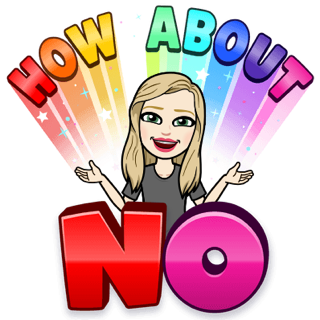
One of my favorite Bitmojis
I stopped leaning in when I realized I was going to get laid off. It was a slow, painful wait. During that time, I switched to leaning into myself. No more events or late nights; I left at 5 pm sharp for SoulCycle classes to burn off my stress. I finished my second book. I worked on my application to Archives Leadership Institute. I wrote book reviews and presentations on my personal projects. I got certified as a Records Manager. Everything I did benefitted me personally and was portable. My efforts came with me when I left my position.
Women are constantly asked to do more for less and we have to stop. Part of it is trying to be likable. Men can say no (or not even be asked) with little repercussions, but women can’t. Have you ever seen a frazzled male executive? I haven’t. But many female ones are in a constant state of frenzy.
Women need to learn the audacity of nope. We need to push back, set boundaries, and ask for more. We need to say "Hell, no." We need to stop doing office housework, staying late, working weekends, and letting other people determine our worth.
A job can be great but it won’t comfort you, make you laugh, or make sweet love to you. It doesn’t give your life meaning. It’s a means to get the life you want.
Lean in where it counts—your personal and professional life. Lean in for education, networking, professional development, writing, side hustles, and hobbies. Lean in for friends, family members, and lovers. Lean in for your community, your spiritual life, and your health. Lean in when you own your own business.
Do your job—and only your job—superbly. That’s it.
Follow me on Pinterest | Instagram | Twitter | LinkedIn | Facebook
June 23, 2018
A 1940s Wedding and Honeymoon
The great part of getting your personal and family archives organized is that you can immediately access and use your materials to learn about your own history. Once I was able to organize my materials, using techniques discussed Creating Family Archives: How to Preserve Your Papers and Photographs, I could research my relatives much easier.
This January, I started a project of scanning, transcribing, and annotating my grandfather's love letters to my grandmother leading up to their marriage in June 1940. The letters are chronologically organized and posted in real-time so you can follow their courtship as it happened. I've also been using the letters to help me decode their photographs, and searching through my photograph collection to decipher some of the details included in the letters.
The series lead up to this date in 1940, when my grandparents got married, then honeymooned at the Jersey shore. Below are some items from my archives from that day.

The wedding invitation
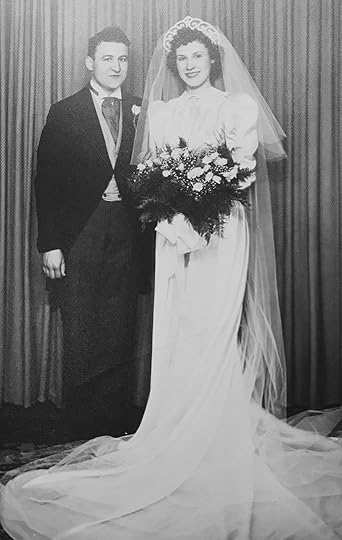
Grandpa and Grandma's wedding photo
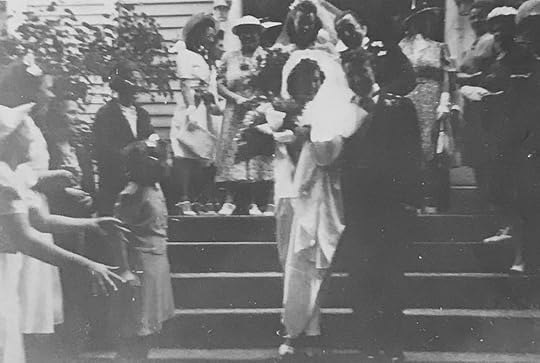
On the church steps
[image error]
My grandma wrote on the back, "Pt. Pleasant, N.J. Honeymoon 1940."
[image error]
My grandma wrote on the back, "Pt. Pleasant, N.J. 1940 Honeymoon."
It makes me a little sad to end this project. I looked forward to posting the letters in real-time, discovering the details of their lives. In some ways, the project was also a study of me. Without them, I wouldn't have had my father. And without my father, there wouldn't be me.
Catch up on the Grandpa's Love Letters series:
To learn the preservation secrets used by libraries, archives, and museums to protect their priceless materials (that you can also use for your family heritage items), read my book:
Creating Family Archives: How to Preserve Your Papers and Photographs
By Margot Note
If you like archives, memory, and legacy as much as I do, you might consider signing up for my email list. Every few weeks I send out a newsletter with new articles and exclusive content for readers. It’s basically my way of keeping in touch with you and letting you know what’s going on. Your information is protected and I never spam.
Ready to get started creating your family archives? Here are some of my favorite products:
Follow me on Pinterest | Instagram | Twitter | LinkedIn | Facebook
June 19, 2018
Letter #31: Groom and Lover
I'm continuing my series of scanning, transcribing, and annotating my grandfather's love letters to my grandmother leading up to their marriage in June 1940. The letters are chronologically organized and preserved, using the methods I discuss in detail in my book, Creating Family Archives: How to Preserve Your Papers and Photographs.
In the final letter of the Grandpa's Love Letters series, Grandpa describes some last minute details before the wedding. Like the letter before, I'm shocked at the prices: $125 for most of the wedding. I compared the results of several historical inflation calculators, and that amount is equivalent to about $2,200 currently.
My brother had mentioned having some letters from my grandparent's as well, so I wonder if some letters are missing.
Here's a lovely picture of Grandma. Is this at Lackawanna River, I wonder?
[image error]
"April 6, 1941:" is written on the back by my Grandma
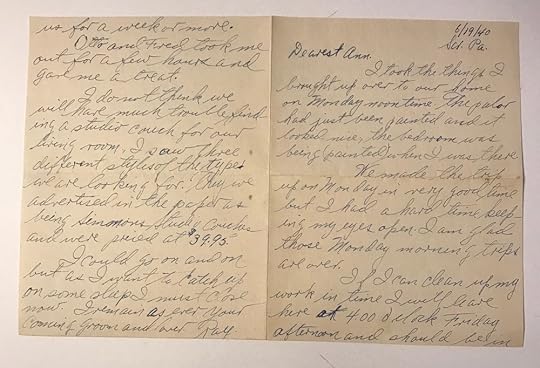
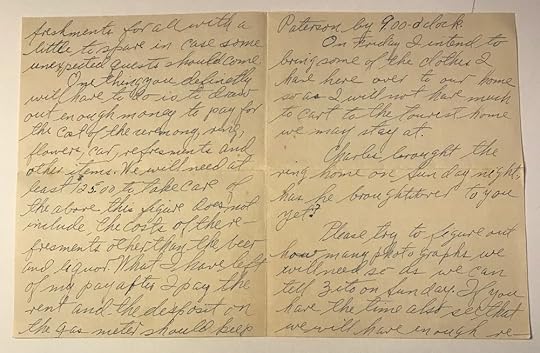
***
6/19/40
Scr. Pa.
Dearest Ann
I took the things I brought up over to our home on Monday noontime. The palor [sic] had just been painted and it looked nice, the bedroom was being (painted) when I was there.
We made the trip up on Monday in very good time but I had a hard time keeping my eyes open. I am glad those Monday morning trips are over.
If I can clean up my work in time I will leave here at 4.00 o'clock Friday afternoon and should be in Paterson by 9.00 o'clock.
On Friday I intend to bring some of the clothes I have here over to our home so as I will not have much to cart to the tourist home we may stay at.
Charles brought the ring home on Sunday night, has he brought it over to you yet?
Please try to figure out how many photographs we will need so as we can tell Zito on Sunday. If you have the time also see that we will have enough refreshments for all with a little to spare in case some unexpected guests should come.
One thing you definitely will have to do is to draw out enough money to pay for the cost of the ceremony, ring, flowers, car, refreshments, and other items. We will need at least $125.00 to take care of the above this figure does not include the costs of the refreshments other than the beer and liquor. What I have left of my pay after I pay then rent and the deposit on the gas meter should keep us for a week or more.
Otto and Fred took me out for a few hours and gave me a treat.
I do not think we will have much trouble finding a studio couch for our living room. I saw three different styles of the type we are looking for. They we [sid] advertised in the paper as being Simonons Studio couches and were priced at $39.95.
I could go on and on but as I want to catch up on some sleep. I must close now. I remain as ever your coming groom and lover. Ray
***
Creating Family Archives: How to Preserve Your Papers and Photographs
By Margot Note
If you like archives, memory, and legacy as much as I do, you might consider signing up for my email list. Every few weeks I send out a newsletter with new articles and exclusive content for readers. It’s basically my way of keeping in touch with you and letting you know what’s going on. Your information is protected and I never spam.
Ready to get started creating your family archives? Here are some of my favorite products:
Follow me on Pinterest | Instagram | Twitter | LinkedIn | Facebook
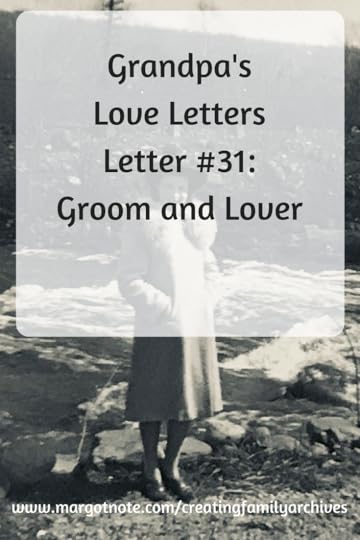
June 18, 2018
Everybody Takes a Beating
My favorite movie is Goodfellas. It’s brilliant, and I feel compelled to watch it anytime it's on TV, even though I've watched it many times. The film is filled with great scenes, but one has been surprisingly the most helpful in my personal and professional life.
In an early scene, Henry Hill, the protagonist, talks about how he started working as a helper at a mafia-run cab stand when he was a young teenager. He wound up skipping school because he loved working there. His father receives a truancy letter in the mail and confronts him. He starts to slap him then beats Henry with a belt. The movie freezes as the blows rain down. Henry delivers the classic line: “The way I saw it, everybody takes a beating sometime.”
In his mind, an occasional beating is worth the thrill of mob life.
This is exactly the kind of attitude you need for the wild world of consulting. (Unlike the characters in Goodfellas, my work is all legal!) The freedom you receive to make your own hours, charge your rates, and pursue work on your terms is worth the once-and-awhile awfulness you encounter. The “beating” you receive is a creepy email, an angry call, or an uncomfortable meeting. It can be unwanted touching or a client not wanting to pay for the services you rendered (sometimes both!)
Often, people are upset about something else and they take it out on you. For example, Henry says, "My father was always pissed off. He was pissed that he made such lousy money. He was pissed that my kid brother, Michael, was in a wheelchair. He was pissed that there was seven of us living in such a tiny house." He continues, "But mostly he was pissed because I hung around at the cab stand. He knew what went on at that cab stand..."
These moments feel awful at the time but they pass. They are part of doing business where you alone have to look out for yourself and set boundaries with clients.
Anger delivered at you is especially hard for people pleasers, like me. I pride myself in delivering great work and delighting my clients. Those of us in the library, archives, and museum worlds love helping others so when we can’t (even for reasons outside of our control), we feel bad. But, to be successful, we cannot rely on others to give us self-worth. We develop more confidence and wisdom with each sticky situation. Tough experiences allow us to become resilient and display true grit.
The most important part of handling these moments is to remain quiet and calm. I don’t engage with people who are upset at me because I haven’t found it helpful and they won’t listen. I also never want to say anything in the moment that would damage our relationship. I wait until they are done and then I leave. At a later time, once the situation has cooled off, I'll determine next steps. I never want to act out of anger or fear, and I always want to behave professionally. I also want to be understanding of people who are having a bad day and move past the incident, if possible.
To shake off the bad feelings, I call someone in my support network (usually my husband who always makes me feel better). I try to get fresh air and then jump into a task that will require my complete concentration for the next hour. Sometime that day, I schedule extra time for self-care or to be physical or both. Spending more time at the gym, sweating it out in a yoga class, or taking a long bath releases the yucky psychic energy lobbed at you.
Luckily, these beatings only happen occasionally and each time I’m getting better at anticipating them and handling them. They just come with self-employment. I've found that consulting work gives me the liberation I need, and as Henry later says, "To live any other way was nuts." I'll take the highs and lows of independent work than, in the another classic line by Henry, "to live the rest of my life like a schnook."
Follow me on Pinterest | Instagram | Twitter | LinkedIn | Facebook
June 11, 2018
Dress Well on a Budget
In a perfect world, no one would care what you wear. The quality of your work would determine what they think of you. Unfortunately, people really do judge books by their cover. This is true of people who make decisions to hire you, especially if you do knowledge work. As a consultant, I am compelled to dress well so that my clients feel like they have invested in quality.
The purpose of this post is to help women create the best packaging for themselves with the least amount of time and money so that they shine. It’s hard to find affordable, high-quality, and professional clothing for women. I wish there was an equivalent of the Men’s Wearhouse where you could buy suits and get them tailored instantly. Josephine A. Banks, where are you?
My recommendations are based on Dress for Success and Dress for Success for Women. These books are classics for a reason and recommend fabrics, colors, and cuts that look luxe without being expensive. Sex and The Single Girl and The Satanic Witch offer great dressing tips too. (Yes, really!).
My wardrobe is tiny, probably a little boring, but well-loved. Dressing well means having less clothes. Think of the French and their chic capsule wardrobes. I cannot afford the luxury of cheap clothes! Everything I buy must be worth it
This post isn't sponsored; I'm just sharing things that work for me.
KonMari Your WardrobeSell, donate, or throw out anything that doesn’t spark joy. Get rid of anything that doesn’t fit, has bad memories, looks frumpy, is stained, or worn out. If you’re not constantly wearing it, it needs to go.
Choose Your SilhouetteI wear skirts and dresses because I can buy them without alteration. Because of my body shape (small waist, curvy behind), it’s hard to find pants that fit without tailoring. Knowing that I only need A-line skirts and dresses filters my shopping and limits my shoe selections. Having a uniform makes my life easier because everything matches. Before I had a uniform, it felt like trigonometry to figure out my outfits.
Decide on a Color PaletteI wear dark colors. Most of my clothes are navy, because it's the color of business and it represents wisdom, strength, and reliability. I also wear a lot of blues because I find dressing in its different shades to be flattering and calming. My bags and shoes are always black. If I buy something within this narrow range, I know that it will work with the rest of my wardrobe.
Shop ClassicsAlways choose an item in a classic style because you can wear it for years. Brooks Brothers is the leader in timeless classics.
I once thought the brand was too preppy and expensive, until I ignored everything that looked too country club, got their credit card to earn rewards, and only shopped their sales. I became a convert.
Their clothing is shockingly affordable in cost-per-wear. Each item is well-constructed, with top quality fabrics, linings, and details, and they last forever.
For the last two years, I bought no new clothing because I didn't have the money. (I was laid off and started my consulting business). I wore a handful of Brooks Brothers pieces consistently throughout that period for client meetings, and they have held up beautifully.
Their customer service is great too. I started recently buying from them again, and in the course of writing this post, I had an order from them delivered and received a handwritten card from them in the mail with a major discount card enclosed.
Tops over BottomsInvest more in clothing from the waist up. You can wear the same skirts over and over, but you usually can’t with shirts because they are too noticeable. Shirts are easier to shop for, offer more variety, and are more fun than skirts. Shirts also tend to wear out and get stained more easily. Everlane offers the best silk tops at great prices.
Blazers over CardigansI’m turning traitor against my librarian roots but cardigans are the clothing item of defeat. I have accepted the fact that they are cozy, but I don't look good in them. Instead, I wear blazers that act as armor. I usually roll or scrunch up the sleeves, because I’m more comfortable that way. Elie Tahari has made an artwork out of luxurious linings, and my sleeves look great when I roll them.
Solids over PatternsPatterns often look cheap or trendy. They are memorable if you wear them often. Solids can pass for better quality at a lower price point, and you can wear them a lot without it being noticeable. I have two shells and one shirt with understated patterns that add interest. The rest are solids. Theory and Equipment do small patterns well.
Spend on AccessoriesI spend where it counts: a few designer bags, two designer belts, and fine jewelry. They are investments that will last a lifetime.
.I try to find earrings that are beautiful and memorable. I have gauged ears, so I wear glass hanging styles from Body Art Forms.
You’re supposed to spend a lot on shoes, but I’m so rough on them that I buy them affordably. I search for classic, pointed toe, black leather flats and heels on Zappos. I usually rotate 2-3 pairs of shoes per season.
I spend on my hair because it's an accessory I wear every day, and I trust my stylist with my life.
I count tattoos as accessories. I got three dumb tattoos when I was 18 that I felt bad about for years. Later, I had to choose between laser removal or tattoo cover-ups--both wildly expensive. I chose half-sleeve cover-ups of magnolia blossoms from Eric Rignall at Inkstop, and it was so worth it. Protip: you want an experienced artist with high rates, who is booked for months in advance, and who works at a shop that only does tattoos.
Some More Tips Dry-clean when you must. Handwash when you should. Don't wash if you don't have to. Wear V-necks under your clothes to protect them from sweat.Get a professional bra fitting.Create workout and leisure uniforms, and buy in bulk. Buy affordable skincare and makeup on sale at CVS's Beauty Club, Makeup Artist's Choice, and The Ordinary. High-end makeup and skin care is more expensive because it has better packaging; the ingredients are often the same as drugstore products. Have signatures. For me, it's Revlon's Cherries in the Snow nail polish and Egyptian Musk perfume.Follow me on Pinterest | Instagram | Twitter | LinkedIn | Facebook
Letter #30: Start Living
I'm continuing my series of scanning, transcribing, and annotating my grandfather's love letters to my grandmother leading up to their marriage in June 1940. The letters are chronologically organized and preserved, using the methods I discuss in detail in my book, Creating Family Archives: How to Preserve Your Papers and Photographs.
In the 30th letter of Grandpa's Love Letters series, Grandpa is making plans for their new apartment. There seems to be a lot of logistical details to take care of before their nuptials.
The line that stuck out to me was: "The more I think of it I become surer that we will at least have our floor coverings, curtains, kitchen set and either a studio couch or a bed room set in our home by Saturday June 29th and then we can start living." "Living" is underlined twice.
As I was looking through photographs to include with this post, I found this one, which I don't think I ever really noticed before:
[image error]
My grandma wrote "7/20/41" on the back of this photograph.
I could probably talk about this photo the way that Barthes discusses the Winter Garden photograph of his mother in Camera Lucida, but I will spare you.
The photograph was taken during her first year of marriage. Look at how she is subtly positioning herself away from her stepfather. Look even how the leg to our left is angled away. She has an unhappy look on her face. Her stepfather was not a good man.
Sometimes I think my grandparents were getting married to also get away from their families.

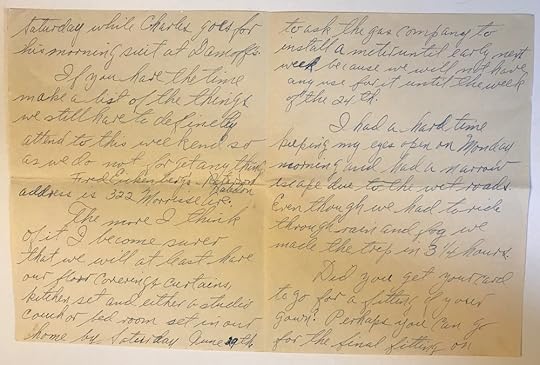
***
6/11/40
Scranton Pa.
Dearest Ann:
The best deal I could make with the gas store was $15.00 down and the balance ($15) on or before July 10th. The woman suspected that we want to try out the stove before we buy it in full.
Do you think it would be a good idea to bring our dishware, pots, pan, etc. up this coming Monday? I have not inquired at the tourist home about rooms as yet but I intend to do so before Friday. I do not intend to ask the gas company to install a meter until early next week because we will not have any use for it until the week of the 24th.
I had a hard time keeping my eyes open on Monday morning and had a narrow escape due to the wet roads. Even though we had to ride through rain and fog, we made the trip in 3-1/4 hours.
Do you get your card to go for a fitting of your gown? Perhaps you can go for the final fitting on Saturday while Charles goes for his morning suit at Damoff's.
If you have the time make a list of the things we still have to definitely attend to this weekend so as we do not forget anything.
Fred Eickenberg's Paterson [crossed out] Haledon address is 322 Morisse Ave.
The more I think of it I become surer that we will at least have our floor coverings, curtains, kitchen set and either a studio couch or a bed room set in our home by Saturday June 29th and then we can start living.
I paid Mrs. Troop $1.50 extra for our week-end stay.
Fred thought that I could at least have gone and told the landlady that he could not make the trip and that she should not hold the rooms until his mother looked at them.
I must close now but not before saying that I love you, I love you, I love you.
Your Sweetheart
"Newt"
***
Creating Family Archives: How to Preserve Your Papers and Photographs
By Margot Note
If you like archives, memory, and legacy as much as I do, you might consider signing up for my email list. Every few weeks I send out a newsletter with new articles and exclusive content for readers. It’s basically my way of keeping in touch with you and letting you know what’s going on. Your information is protected and I never spam.
Ready to get started creating your family archives? Here are some of my favorite products:
Follow me on Pinterest | Instagram | Twitter | LinkedIn | Facebook
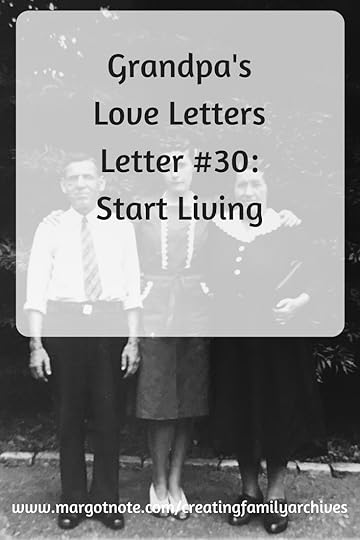
June 5, 2018
Letter #28 and #29: Apartment Hunting
I'm continuing my series of scanning, transcribing, and annotating my grandfather's love letters to my grandmother leading up to their marriage in June 1940. The letters are chronologically organized and preserved, using the methods I discuss in detail in my book, Creating Family Archives: How to Preserve Your Papers and Photographs.
The latest entries for the Grandpa's Love Letters series are double letters. One was written in the afternoon, while the other was written that night. Grandpa is looking for a new place to move into once they got married. The options are interesting--an apartment with a shared bathroom for $23 rent or one in an attic for $25. Is the rent weekly? Monthly?
The first letter lost its diagram of the apartment, but the second letter has an overview of what the apartment would look like.
Which one did they choose?
[image error]
"Ann + Ray Note" is written on the back by Grandma.
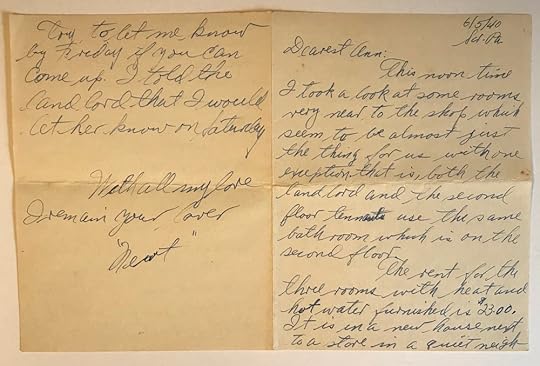
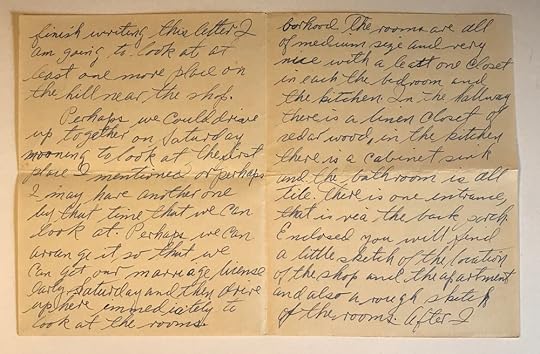
***
6/5/40
Scr. Pa.
Dearest Ann:
This noon time I took a look at some rooms very near to the shop which seem to be almost just the thing for us with one exception, this is, both the landlord and the second floor tenants use the same bathroom which is on the second floor.
The rent for the three rooms with heat and hot water furnished is $23.00. It is in a new house next to a store in a quiet neighborhood. The rooms are all of medium size and very nice with a[t] least one closet in each the bedroom and the kitchen. In the hallway there is a linen closet of cedarwood, in the kitchen there is a cabinet sink and the bathroom is all tile. There is one entrance, that is nea[r] the back porch. Enclosed you will find a little sketch of the location of the shop and the apartment and also a rough sketch of the rooms. After I finish writing this letter I am going to look at at least one more place on the hill near the shop.
Perhaps we could drive up together on Saturday morning to look at the first place I mentioned or perhaps I may have another one by that time that we can look at. Perhaps we can arrange it so that we can get our marriage license early Saturday and then drive up here immediately to look at the rooms.
Try to let me know by Friday if you can come up. I told the landlord that I would let her know on Saturday.
With all my love,
I remain your lover
"Next"
***
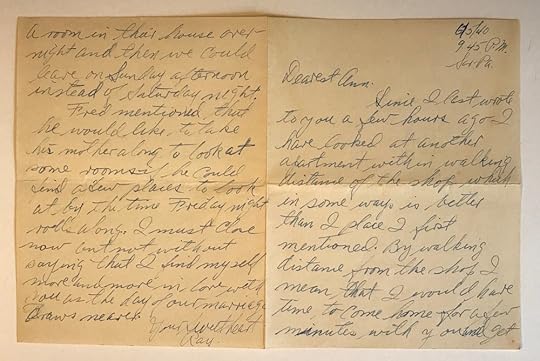
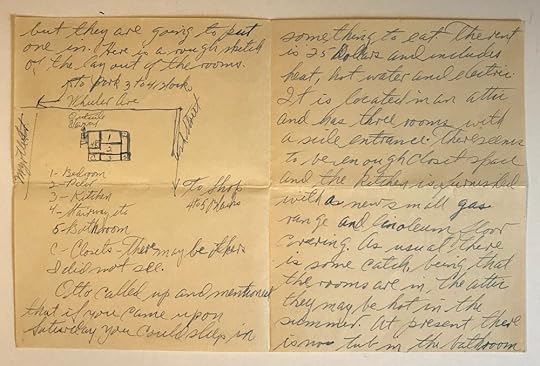
6/5/40
9.45 P. M.
Scr. Pa.
Dearest Ann:
Since I last wrote to you a few hours ago I have looked at another apartment within walking distance of the shop which in some ways is better than [the] place I first mentioned. By walking distance from the shop I mean that I would have time to come home for a few minutes with you and get something to eat. The rent is 25 Dollars and includes heat, hot water and electric. It is located in an attic and has three rooms with a side entrance. There seems to be enough closet space and the kitchen is furnished with a new small gas range and linoleum floor covering. As usual there is some catch, being that the rooms are in the attic they may be host in the summer. At present is no tub in the bathroom but they are going to put one in. Here's a rough sketch of the layout of the rooms.
Otto called me up and mentioned that if you came up on Saturday, you could sleep in a room in their house overnight and then we could leave on Sunday afternoon instead of Saturday night.
Fred mentioned that he would like to take his mother along to look at some rooms if he could find a few places to look at by the time Friday night rolls along. I must close now cannot without saying that I find myself more and more in love with you as the day of our marriage draws nearer.
Your Sweetheart
Ray
***
Creating Family Archives: How to Preserve Your Papers and Photographs
By Margot Note
If you like archives, memory, and legacy as much as I do, you might consider signing up for my email list. Every few weeks I send out a newsletter with new articles and exclusive content for readers. It’s basically my way of keeping in touch with you and letting you know what’s going on. Your information is protected and I never spam.
Ready to get started creating your family archives? Here are some of my favorite products:
Follow me on Pinterest | Instagram | Twitter | LinkedIn | Facebook




